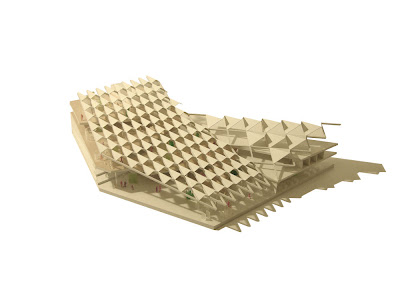












One large roof covers all functions in the building. The roof is a large elegant wooden structure with numerous openings. The openings bring in abundant amounts of daylight and allow for direct view of the sea from all places in the building, up and down. In this way, the light and friendly atmosphere sought for by the bank is achieved.
The 83 prism like skylights compose the spectacular roof surface defining the geometry of the rest of the building – in reference to the maritime environment on the harbor front as well as the surrounding timber framed buildings. The roof is designed to frame a perfect view towards the Lillebælt waters as well with a functional purpose of shading from direct sunlight.µThe new building is carefully fitted into the context. To one side, the village is respected by following dimensions, scale and the shape of the roof. Towards the harbour the building retracts and makes way for a new, triangular space that opens for the view. From the plaza, one enters a large, indoor ‘market place’, the heart of the building. At entrance level, a bookshop, a café and a real estate agent and the cash desk is placed.
Thermoactive Hydronic Elements
The method utilizes the mass and ability of concrete to adjust the room temperature by absorbing and releasing heat. The method is based upon pre-fabricated concrete decks with embedded plastic pipes.
Large Energy SavingsWith these thermoactive concrete elements it is possible to reduce the energy consumption for heating by 30 percent and the energy consumption for cooling and mechanical ventilation by up to 85 percent; in total, an energy saving of 30-50 percent. This is due to the fact that the system allows for better use of alternative supply sources, i.e. the plant can operate as a low- temperature floor heating system during winter, based upon heat-driven heat pumps, and during summer, the cool night air, soil tubes, ground water or sea water can be used for cooling.
The system is partly self-regulating as water for heating and/or cooling is circulated with a temperature only a few degrees from the desired room temperature, and this is the key to the large energy savings. In addition to energy savings the capital costs were lower due to the reduced needs for cooling and heating.
Nema komentara:
Objavi komentar